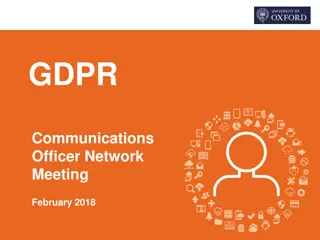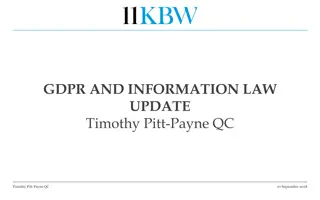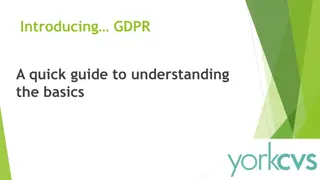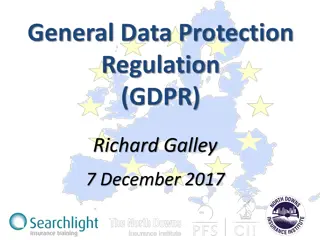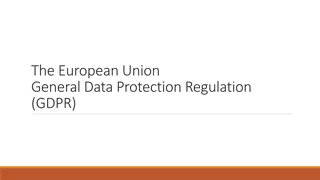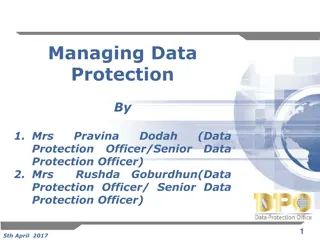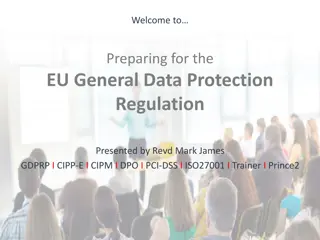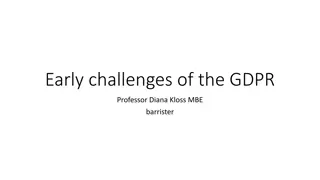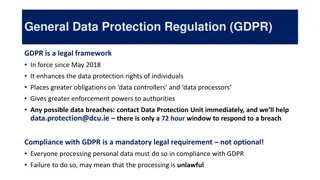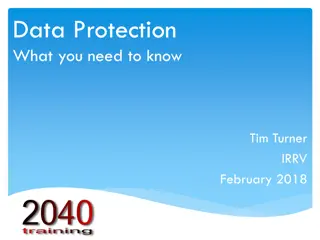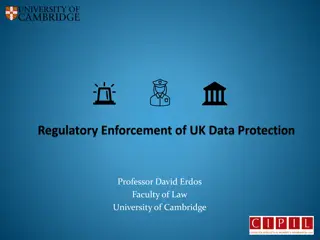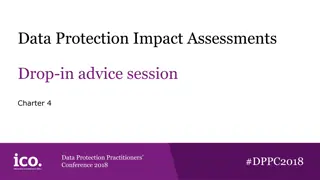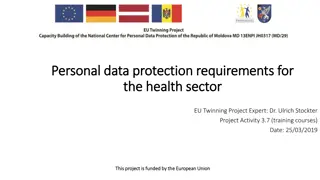Understanding the Role of Data Protection Officers (DPOs) in GDPR Compliance
Explore the key aspects of DPO responsibilities in data protection reform, including their tasks, relationship with controllers, and role in ensuring compliance with GDPR regulations. Learn how DPOs contribute to safeguarding personal data rights, cooperating with supervisory authorities, and addressing evolving data protection challenges within EU institutions and bodies.
Download Presentation

Please find below an Image/Link to download the presentation.
The content on the website is provided AS IS for your information and personal use only. It may not be sold, licensed, or shared on other websites without obtaining consent from the author. Download presentation by click this link. If you encounter any issues during the download, it is possible that the publisher has removed the file from their server.
E N D
Presentation Transcript
New DPOs & data protection reform how to take off? EDPS Training, Supervision and Enforcement Unit 29 May 2018
Aim of this training DPO what? DPO how? DPO take off! 2
Legislation: latest news Privacy + data protection are fundamental rights 'Everyone has the right to the protection of personal data concerning them. -> EU Charter Article 8 + Lisbon Treaty Article 16 Member State level: *NEW* General Data Protection Regulation (GDPR) 25 May 2018 Regulation (EC) 45/2001 on the protection of personal data by EU institutions and bodies Reform: 2018 NEW Regulation for EUIs data protection compliance becomes part of your institution s governance You institution s implementing rules + Rules of procedure (to be updated) 3
The EDPS & You 65 EU institutions + bodies European Data Protection Supervisor (EDPS) Your institution Data Protection Officer (DPO) Controller Controller Wojciech Wiewi rowski Giovanni Buttarelli Data subjects 4
The EDPS Supervise data processing done by EU institutions and bodies; Advise EU legislator and appear before the EU courts; Monitor new technologies with an impact on privacy; Cooperate with other supervisory data protection authorities. Provide Secretariat to European Data Protection Board (EDPB) & participate as member in its activities 1. 2. 3. 4. 5. 5
The players Top management Accountable DPO Your Business owner Responsible counsellor IT department Your designer Processor Your executor 6
DPOs tasks... evolving NB: The DPOs are not the controller. They are not responsible for the lawfulness of processing operations! Internal advisor to identify risks related to processing Proximity to controller Knowledge of institution Contributes to set up procedures follow up of complaints, audits, privacy by design, personal data breach notifications Contact point for data subjects to be mentioned in Privacy statement *New* 7
EDPS and DPOs EDPS web site: DPO corner with starter kit Professional Standards for Data Protection Officers Professional Standards for Data Protection Officers & Role of a Data Protection Officer Professional Standards for Data Protection Officers Role of a Data Protection Officer Practical advice, templates, presentatio ns etc. New to be published soon: EDPS paper on DPOs (following DPO consultation currently under finalisation) https://edps.europa.eu/data-protection/eu-institutions-dpo_en 8
EDPS & DPOs Bi-annual EDPS/DPO meeting Collaborative online platform CIRCA EDPS hotline each Thursday EDPS DPOs Accountability questionnaire EDPS DPO corner available at https://edps.europa.eu/data-protection/eu-institutions-dpo_en 9
DPOs key actions: awareness raising Inventory of processing operations (= cartographie / mapping ) Table containing all existing and planned future procedures Serves as basis for records & planning Recommendation: have this table updated at least once a year by management for inspiration EDPS template: Website EDPS -> DPO corner-> Inventory Privacy by design + privacy by default *NEW* Ensure to be involved in each new project/manual revision from the outset in new processing operations (e.g. tick box in project vision document), IT steering committee etc. DPO associated to procurement procedures leading to personal data processing Intranet website for staff (including register of notifications/records) 28 January Data protection day Awareness raising campaign in your body/with other bodies: trainings involving Quiz, presentations, breakfast, debates with guest speakers, etc 10
Records & Privacy statements DPOs bread & butter tasks Internal documentation To be drafted by Controller w DPO Allows risk assessment Records Art. 31 Data Protection Impact Assessment - Art. 39 very limited cases: where a processing is likely to result in a high risk for rights and freedoms of natural persons Privacy statements Art. 14-16 Inform people Before collecting data = fair processing 11
Records DPOs bread & butter tasks Contain elements listed in Art. 31 Records kept in (ideally public) register of processing operations may need to be demonstrated to EDPS upon request For standard processings & corresponding Privacy statements - get inspired by EDPS: https://edps.europa.eu/data-protection/eu-institutions- dpo/dpo-register_en COM: http://ec.europa.eu/dpo-register/search.htm On substance: get inspired by thematic EDPS Guidelines & prior check opinions 12
How to draft your records? Take current notifications (Art.25/27) Use the EDPS records template & adapt to your institution Fill in each item with the relevant information and update information by Controller in practice Director, HoU EDPS toolkit Accountability on the ground: Provisional guidance on documenting processing operations for EU institutions, bodies and agencies (6 Feb 2018) https://edps.europa.eu/data-protection/our-work/our-work-by- type/guidelines_en 13
Step by step: Take current Notification INFORMATION TO BE GIVEN(2) (2) Please attach all necessary backup documents 1/ Name and adress of the controller Executive Director EU institution XXX 2/ Organisational parts of the institution or body entrusted with the processing of personal data Administration Department (ADMIN), more specifically HR unit 3/ Name of the processing Health Data of Staff employed 4/ Purpose or purposes of the processing Fulfillment of legal requirement as per the Staff Regulations upon engagement and on annual basis as well as the development of a preventive culture with respect to health. 5/ Description of the category or categories of data subjects XXX statutory and non statutory staff 6/ Description of the data or categories of data(including, if applicable, special categories of data (article 10) and/or origin of data) The patient s name and first name; the doctor's name and first name; where the patient is staying; the foreseeable duration of the incapacity for work, specifying the start and end dates; Ability to work certificate (pre-recruitment). Please refer to the policy for the processing of health data for more details. 7/ Information to be given to data subjects 14 Staff is informed about the procedures via intranet announcement.
Check template items of information (1-13) - exemple Annex 1 Template for records and compliance check (based on EDPS draft guidelines) Nr. Item Reference number and version (publicly available) Last update of this record Reference number Part 1 Article 31 Record (publicly available) Name and contact details of controller Name and contact details of DPO Value Explanation 1. 2. For tracking from central XXX register 3. dataprotection@xxx.europa .eu 4. Name and contact details of joint controller (where applicable) If XXX is jointly responsible with another EU institution (EUI), please indicate so here. If this is the case, make sure to mention in the description who is in charge of what and to whom people can address their queries. If you use a processor (contractor) to process personal data on XXX s behalf, please indicate so (e.g. 360 evaluations, outsourced IT services, use of data processing tools or pre-employment medical checks). Very concise description of what you intend to achieve; if you do this on a specific legal basis, mention it as well (e.g. staff regulations for selection procedures). In case data categories differ between different categories of persons, please explain as well (e.g.: suspects vs. witnesses in administrative inquiries). 5. Name and contact details of processor (where applicable) 6. Purpose of the processing 7. Description of categories of persons whose data are being processed (data subjects) and list of data categories. 8. 15
III.a Comply with DP principles Part 2 - compliance check and risk screening (internal) Compliance check (Articles 4 and 5) Legal basis and necessity for processing (see Article 5 of the proposal): Choose (at least) one and explain why the processing is necessary for it. 14. Examples: (a) a task attributed to XXX by legislation, e.g. procedures under the staff regulations or tasks assigned by the Agency s founding regulation. Please mention the specific legal basis (e.g. Staff Regulations Article X, as implemented by XXX IR Article Y , instead of just Staff Regulations ) (a2) not all processing operations required for the functioning of XXX are explicitly mandated by legislation; recital 17 explains that they should nonetheless be seen to be covered here, e.g. internal staff directory, access control. (b) a specific legal obligation to process personal data, e.g. obligation to publish declarations of interest in XXX s founding regulation. (c) this is rarely used by the EUIs. (d) if persons have given free and informed consent, e.g. a photo booth on EU open day, optional publication of photos in internal directory; (e) e.g. processing of health information by first responders after an accident when the person cannot consent not so relevant to XXX. (a) necessary for performance of tasks in the public interest attributed by EU or MS legislation (a2) (a) as per recital 17, second sentence (b) necessary for compliance with legal obligation incumbent on controller (c) necessary for performance of a contract to which the DS is party (d) consent (e) vital interest Purpose definition: Do you list all purposes in point 7 above? Are the purposes specified, explicit, and legitimate? Where information is also processed for other purposes, are you sure that these are not incompatible with the initial purpose(s)? Data minimisation: Do you really need all data items you plan to collect? Are there any you could do without? Explain in more detail the purpose and its legitimacy and competence of XXX to achieve it. Be as more detailed and explicit as possible; cover all possible cases. 15. Explain clearly why the different categories of data are needed; cover all possible cases of the data processing. 16. 16
III.d Comply with DP principles Part 2 - compliance check and risk screening (internal) Compliance check (Articles 4 and 5) Accuracy: How do you ensure that the information you process about people is accurate? How do you rectify inaccurate information? E.g. information may be collected directly from the persons; there might be available means for the persons to directly check and rectify it. 17. Storage limitation: Explain why you chose the storage period(s) mentioned in point 9 above. Are they limited according to the maxim as long as necessary, as short as possible ? In case you only need some information for longer, can you split storage periods? Note that data may be kept after the legitimate retention period in anonymised form (i.e. individuals are no longer identified or identifiable). Consult the DPO for further info if needed. 18. Transparency: How do you inform people about the processing? E.g. privacy statements on forms, e-mail notifications: provide more detail on different types of information. If you do not want to inform people (or only inform them after the processing has been performed), consult the DPO. 19. Access and other rights of persons whose data you process: How can people access, rectify or delete their data? Who should they contact and how? Are there cases where access, rectification or deletion is not permitted and why? Explain clearly the procedures for access, rectification and deletion of personal data. Clearly mention contact points (e.g. an email address or specific person) that will handle such requests. If there could be situations where you would want to refuse e.g. granting access, consult the DPO. 20. Where are your information security measures documented? Provide a link to relevant information security documentation if available. Otherwise, provide more detailed description of applicable measures. 21. 17
Record: Selection of experts (Extracted from data protection register) Title Call for expression of interest :Experts N/A EDPS case Number Notified John Doe john.doe@ec.Europa.eu, Head of Unit ICT Administration and Support Procurement Notification Status Controller Name 1.a. Part of the Institution 1.b. Processors 1.c. Contact Person 2. Name of the Proccessing CEI list of experts Establishing a list of Experts for identifying emerging and future risks posed by new ICTs (See attached document) 16/06/2011 External experts hired by XXX for specific tasks 3. Purpose of the Processing Date of Submission 4. Description of the category of data subjects 5. Description of the data or categories of the data 1. Name and address of the applicant 2. CV of the applicant 3. Personal Tax File (Fiscal) Number 4. Application form Call for expression of interest. 5. Solemn declaration that candidates are not in a situation of conflict of interests Information provided through the application form (data subjects are required to give their consent). Privacy Notice to be updated. By email to the 'Procurement' mailbox. By email to the 'Procurement' mailbox. By email to the 'Procurement' mailbox. By email to the 'Procurement' mailbox. By email to the 'Procurement' mailbox. 6. Information to be given to data subjects Right to have access Right to rectify Right to block Right to erase Right to object 18
Record: Selection of experts Title Call for expression of interest : Experts Manual Processing operation 8. Automated/ manual processing operation 9. Storage space and storage media 10. Legal basis 11. Recipients Files are kept on Intranet (initially on a restricted basis - successful applicants are then are open for perusal by staff only). The Financial Regulation and the Implementing rules; data subject's consent. Procurement Team, Appointed members of the evaluation panel. Staff members when needs for expertise have been duly identified to carry out projects. Data are kept as long as the CEI is open (4 years) to applications and for a period of one year after closure of the procedure. 12. Retention policy for categories of data 13.a. Time limits 13.b. Historical, statistical purpose 14. Proposed transfers of data How and when 15. Specific risks 16. Comments 17. Measures to ensure security of processing Attachments N//A N/A N/A N/A - All files related to CEI processing are exclusively stored on the intranet. Contract.pdf 19
Practical questions Given that your EU institution organises several expert selection rounds every year, how would you proceed in terms of records ? Is a new record necessary every time you organise an event? How to ensure consistency across your EUI? No! Harmonise your procedure and indicate differences (where necessary) in one record. e.g.: COM Model notifications for experts, event organisation etc. 20
When to carry out a DPIA? Processing is on the list of kinds of risky processing operations to be issued by the EDPS Processing is likely to result in high risks according to your threshold assessment EDPS Toolkit Accountability on the ground: Provisional guidance on documenting processing operations for EU institutions, bodies and agencies , section 4 and Annex 5 & 6 for threshold assessment 21
DPIA or not? registration of journalists and other visitors Large scale profiling data bases: Europol DPIAs or not? Processing of genetic or biometric data payroll processing Large scale processing of vulnerable data subjects (i.e children) staff selection procedures and recruitment NB: Even if no DPIA, still risk assessment 22
How to demonstrate compliance? Before collecting data inform persons = fair processing Review and update privacy statements information in an intelligible and easily accessible form, using clear and plain language : identity of the controller, purpose, recipients, rights, legal basis... *NEW* contact details of the DPO, info on transfers to recipients outside the EU. How? Data protection notice on intranet, internet, on paper forms ... 23
In a nutshell Unit designs new processing operation Collection, storage, transfer Privacy by design & by default! EDPS thematic Guidelines for inspiration 1 Privacy statements Drafted by Controllers *New* for Controller: records + risk assessment 2 3 3 DPO advises on conformity with Regulation 4 Register by DPO *New*: Records to be kept by Controller Launch procedure Verification by EDPS DPIAs only in limited cases 26
Get involved in outsourcing (Article 29) eg: SLA, procurement, external experts... Controllers and processors both accountable! Privacy as award criterion: Procure secure Remember privacy by design & by default Review, update and renegotiate contract clauses Clarify roles controller/processor Contractual safeguards (security, confidentiality) Processor should act only on behalf of the controller Privacy statements, no sub-sub-contracting... Controller can verify compliance via audits 27
Breach notifications EUI to notify the EDPS not later than 72h *NEW* not only hacking, theft etc... but also disclosure of correspondance, laptop or usb stick loss etc... DPO to contribute to draft new procedure, e.g. update existing IT security incident procedure - > include LISO, IT, management See circa for inspiration, there are examples Include reporting obligation on newcomers training, undertake awareness raising exercises etc. 28
Factsheet What to expect when we inspect https://edps.europa.eu/data-protection/our-work/publications/factsheets/factsheet-5-what-expect- when-we-inspect_en & EDPS Rules of procedure, Articles 15(3) and 36 29
What now? Take aways
DPOs plan lets take off!! Establish transition action plan & request management support see circa for inspiration Update implementing rules Update inventory + templates: Records & PS Existing processing controllers to update content & re-check lawfulness New processing operation - ensure to be involved Project vision document, steering committees, Inventory... Implement Privacy by design & by default: check compliance with DP rules from the outset of all projects/manuals Get inspired by EDPS thematic Guidelines New procurement including personal data? Contribute to draft tender data protection specifications & use specific clauses & PS Initiate drafting of personal data breach procedure People ask access to their personal data or rectification? People have rights. Inform & ensure follow up with Controllers. 31
Q? A! For more information: www.edps.europa.eu edps@edps.europa.eu Subscribe to our monthly newsletter (click)


